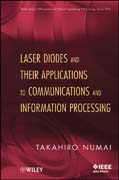
Laser diodes and their applications to communications and information processing
Numai, Takahiro
INDICE: PREFACE. PART I PHYSICS REQUIRED TO DESIGN LASER DIODES. 1 Energy Bands in Bulk and Quantum Structures. 1.1 Introduction. 1.2 Bulk Structure. 1.3Quantum Structures. 1.4 Superlattices. References. 2 Optical Transitions. 2.1Introduction. 2.2 Direct and Indirect Transitions. 2.3 Light-Emitting Processes. 2.4 Spontaneous Emission, Stimulated Emission, and Absorption. 2.5 OpticalGains. References. 3 Optical Waveguides. 3.1 Introduction. 3.2 Two-Dimensional Optical Waveguides. 3.3 Three-Dimensional Optical Waveguides. References. 4 Optical Resonators. 4.1 Introduction. 4.2 FabryPerot Cavity. 4.3 Waveguide Grating. 4.4 Vertical Cavity. References. 5 pn- and pnpn-Junctions. 5.1 IntrinsicSemiconductor. 5.2 Extrinsic Semiconductor. 5.3 pn-Junction. 5.4 pnpn-Junction. References. PART II CONVENTIONAL LASER DIODES. 6 FabryPerot Laser Diodes. 6.1 Introduction. 6.2 Rate Equations. 6.3 Current versus Voltage Characteristics. 6.4 Current versus Light Output Characteristics. 6.5 Polarization of Light.6.6 Transverse Modes. 6.7 Longitudinal Modes. 6.8 Modulation Characteristics.6.9 Noises. References. 7 Quantum Well Laser Diodes. 7.1 Introduction. 7.2 Features of Quantum Well LDs. 7.3 Strained Quantum Well LDs. References. 8 Single-Mode Laser Diodes. 8.1 Introduction. 8.2 DFB LDs. 8.3 DBR LDs. 8.4 Vertical Cavity Surface-Emitting LDs. References. 9 Semiconductor Optical Amplifiers. 9.1 Introduction. 9.2 Signal Gain. 9.3 Polarization. 9.4 Noises. References. PARTIII ADVANCED LASER DIODES AND RELATED DEVICES. 10 Phase-Controlled DFB LaserDiodes. 10.1 Introduction. 10.2 Theoretical Analysis. 10.3 Device Structure. 10.4 Device Characteristics and Discussion. 10.5 Summary. References. 11 Phase-Shift-Controlled DFB Laser Diodes. 11.1 Introduction. 11.2 Theoretical Analysis. 11.3 Device Structure. 11.4 Device Characteristics and Discussion. 11.5 Summary. References. 12 Phase-Controlled DFB Laser Filter. 12.1 Introduction. 12.2 Device Structure. 12.3 Device Characteristics and Discussion. 12.4 Summary.References. 13 Phase-Shift-Controlled DFB Filter. 13.1 Introduction. 13.2 Theoretical Analysis. 13.3 Device Structure. 13.4 Device Characteristics and Discussion. 13.5 Summary. References. 14 Passive Phase-Shifted DFB Filter. 14.1 Introduction. 14.2 Theoretical Analysis. 14.3 Device Structure. 14.4 Device Characteristics and Discussion. 14.5 Summary. References. 15 Two-Section FabryPerot Filter. 15.1 Introduction. 15.2 Theoretical Analysis. 15.3 Device Structure.15.4 Device Characteristics and Discussion. 15.5 Summary. References. 16 Optical Functional Devices with pnpn-Junctions. 16.1 Introduction. 16.2 Edge-Emitting Optical Functional Device. 16.3 Surface-Emitting Optical Functional Device. References. PARTIV SYSTEM DEMONSTRATIONS USING ADVANCED LASER D
- ISBN: 978-0-470-53668-1
- Editorial: John Wiley & Sons
- Encuadernacion: Cartoné
- Páginas: 390
- Fecha Publicación: 28/10/2010
- Nº Volúmenes: 1
- Idioma: Inglés
